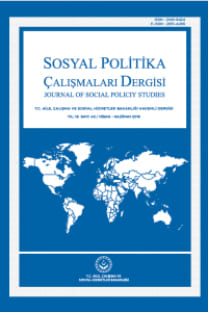AVRUPA 2020 STRATEJİSİNİN SONUNA GELİRKEN: NEİY
Bu makale 15-24 yaş aralığında, ne eğitimde ne istihdamda ne de yetiştirmede (NEİY) yeralan gençler ile ilgili literatür taraması yapmakta ve Avrupa Birliği (AB) bünyesinde bu konuyailişkin güncel durumu makro düzeyde incelemektedir. Genç işsizliğinin AB’nin önceliklerinden biri olması sebebiyle beşeri sermayeye yapılacak yatırım, gençlerin istihdam edilebilirliğive sosyal içermeleri açısından önem arz etmektedir. Günümüzde AB’nin amaçlarının yaşlanannüfus ve yüksek genç işsizliği oranlarına ilişkin sorunları çözmek ve dünya çapında rekabetedebilirliğe ek olarak akıllı, sürdürülebilir ve kapsayıcı büyümeyi elde etmek olması nedeniyle, genç nüfusun önemine vurgu yapılmaktadır. Bu makale, Avrupa 2020 Stratejisinin NEİYsorununa çözüm bulmakta başarılı olup olmadığı sorusuna cevap aramaktadır. Bu konuyu elealırken, öncelikle NEİY sınıflandırması ve olası nedenleri incelenmektedir. Sonrasında, 2019yılının güncel verileri ışığında AB’nin Avrupa 2020 Stratejisindeki hedeflerinde ne aşamadaolduğu irdelenmekte ve bu araştırmada sadece istihdam ve eğitim verileriyle başarılı sonuçlarelde edilemeyeceği gösterilmektedir. Daha sonra, istihdam ve eğitim alanlarının dışında kalmanın ekonomik ve sosyal alanlarda yarattığı risklere odaklanılmaktadır. Son olarak, AB’ninsöz konusu alanlarda yürütmekte olduğu politikalara yönelik eleştiriler ve bundan sonrakistratejilerin oluşturulması sürecinde dikkate alınması gereken öneriler sunulmaktadır.
Approachıng The End ‘Europe 2020’: Neet
This paper provides a literature review on the group aged between 15-24, who are not in employment, education or training (NEET) and it examines the current situation in the European Union (EU) at macro level. Since young unemployment is one of the major concerns of the EU, investing in human capital is essential both for employability and social inclusion of the youth. Since the recent objectives of the EU aim to tackle ageing population and high rates of young unemployment; and to obtain smart, sustainable and inclusive growth in addition to worldwide competitiveness, they emphasise on the crucial role of the young population. This paper tries to answer the question whether the ‘Europe 2020’ is successful in terms of coping with the problem of NEET. While analysing this issue, firstly it examines the categorisation and the potential reasons for being NEET. Then, in the light of the current data of the second quarter of 2019, it figures out the state of play considering the targets of ‘Europe 2020’. It demonstrates that the success cannot be achieved by the data regarding merely employment and education. Moreover, it focuses on the risks emerged both on the economic and social areas due to remaining outside the education and labour market. Lastly, criticism towards the current policies of the EU and recommendations for the following strategy document is presented.
___
- Balan, M. (2017). ‘European and National Policies Regarding Social Inclusion of NEET Youths’. Hyperion International Journal of Econophysics & New Economy. Vol. 10 Issue 2, p.136-156.
- Communication from the Commission. (2010). Europe 2020 A Strategy for Smart, Sustainable and Inclusive Growth. Council of the European Union (2013). Council Recommendation of 22 April 2013 on establishing a Youth Guarantee.
- Delmas, A. (2015). ‘Perspectives for revision of the Europe 2020 Strategy’. Opinions of The Economic, Social and Environmental Council.
- ETF (2015). ‘Young People Not in Employment, Education or Training (NEET). An Overview In ETF Partner Countries’.
- Eurofound (2012a), ‘NEETs – Young people not in employment, education or training: Characteristics, costs and policy responses in Europe’, Publications Office of the European Union, Luxembourg.
- Eurofound (2012b), Recent policy developments related to those not in employment, education and training (NEETs). Available from: https://www.eurofound.europa.eu/observatories/emcc/comparativeinformation/recent-policy-developments-related-to-those-not-inemployment-education-and-training-neets
- Eurofund (2012c). ‘Young People and ‘NEET’s’ infographic’. Available from: https://www.eurofound.europa.eu/emcc/labourmarket/youthinfographic Eurofound (2016), ‘Exploring the diversity of NEETs’, Publications Office of the European Union, Luxembourg
- Eurofound (2017), Long-term unemployed youth: Characteristics and policy responses, Publications Office of the European Union, Luxembourg. Eurofund (2018). ‘NEETs’. Available from: https://www.eurofound.europa.eu/ topic/neets.
- OECD (2019), Youth not in employment, education or training (NEET) (indicator). doi: 10.1787/72d1033a-en (Accessed on 19 May 2019).
- World Bank (2014). ‘Tunisia - Breaking the barriers to youth inclusion (English)’. Washington, DC: World Bank Group. Available from: https:// www.worldbank.org/content/dam/Worldbank/document/MNA/tunisia/ breaking_the_barriers_to_youth_inclusion_eng.pdf
- ISSN: 2148-9424
- Yayın Aralığı: Yılda 4 Sayı
- Başlangıç: 2012
- Yayıncı: Aile,Çalışma ve Sosyal Hizmetler Bakanlığı
